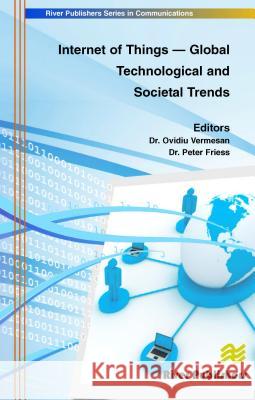Internet of Things - Global Technological and Societal Trends: Smart Environments and Spaces to Green Ict » książka
Internet of Things - Global Technological and Societal Trends: Smart Environments and Spaces to Green Ict
ISBN-13: 9788792329738 / Angielski / Twarda / 2011 / 338 str.
Internet of Things - Global Technological and Societal Trends: Smart Environments and Spaces to Green Ict
ISBN-13: 9788792329738 / Angielski / Twarda / 2011 / 338 str.
(netto: 729,79 VAT: 5%)
Najniższa cena z 30 dni: 592,52
ok. 16-18 dni roboczych
Dostawa w 2026 r.
Darmowa dostawa!
Internet of Things-- Global Technological and Societal Trends builds on the ideas put forward by the European research Cluster on the Internet of Things Strategic Research Agenda. It presents global views and state-of-the-art results on the challenges the research, development, and deployment of Internet of Things (IoT) face at the global level. The objective of this book is to define the IoT in a global view and present the research agenda for IoT technologies by addressing the new technological developments and providing a global balanced coverage of the challenges and technical and industrial trends.
Energy consumption by the data, communication, and networking devices and global CO2 emission are increasing exponentially. ICT has a dual role in this process, accounting for about two percent of global CO2 emissions and at the same the ICT, including IoT technologies and applications that have a direct effect on lowering CO2 emissions. This increases energy efficiency, reduces power consumption, and achieves efficient waste recycling.
IoT put together with the other emerging Internet developments such as Internet of Energy, Media, People, Services, and Business/Enterprises are the backbone of the digital economy and digital society and the foundation for the future knowledge based economy and innovation society. IoT developments show that we will have 16 billion connected devices by the year 2020, which will average out to six devices per person on earth. Devices like smart phones and machine to machine (M2M) or thing to thing communication will be the main drivers for further IoT development.
The first direct consequence of the IoT is the generation of huge quantities of data where every physical or virtual object may have a digital twin in the cloud, which could be generating regular updates. The IoT contribution is in the increased value of information created by the number of interconnections among things and the transformation of the processed information into knowledge for the benefit of mankind and society. The IoT market is connected to industrial M2M systems, smart meters, and enabling technologies such as nanoelectronics, communications, sensors, smart phones, embedded systems, cloud computing, and software technologies that will create new products, new services, new interfaces by creating smart environments, and smart spaces with applications ranging from smart transport, cities, buildings, energy, grid, to smart health, and life.
Technical topics discussed in Internet of Things-- Global Technological and Societal Trends include:
- The Internet of Things: The Way Ahead
- Internet of Things Strategic Research Agenda
- Challenges of a Sustainable Roadmap for the Internet of Things
- Technologies behind Internet of Things: From Nanoelectronics and Embedded Systems to Cloud Computing and Cognitive Systems
- Machine to machine (M2M) communication and the emerging Internet of Things applications
- The -Internet of Things- based on IPv6. Paving the way to Smart IPv6 Buildings
- -Internet of Things - from Ubiquitous Computing to Ubiquitous Intelligence Applications-
- Virtualization of network resources and Physical devices in Internet of Things applications- Validation and Interoperability challenges for IoT
- Mobile devices enable IoT evolution from industrial applications to mass consumer applications
- Interoperability, Standardisation and Governance in the era of Internet of Things (IoT)
- Technologies, Applications, and Governance in the Internet of Things
- Opportunities, Challenges for Internet of Things Technologies











